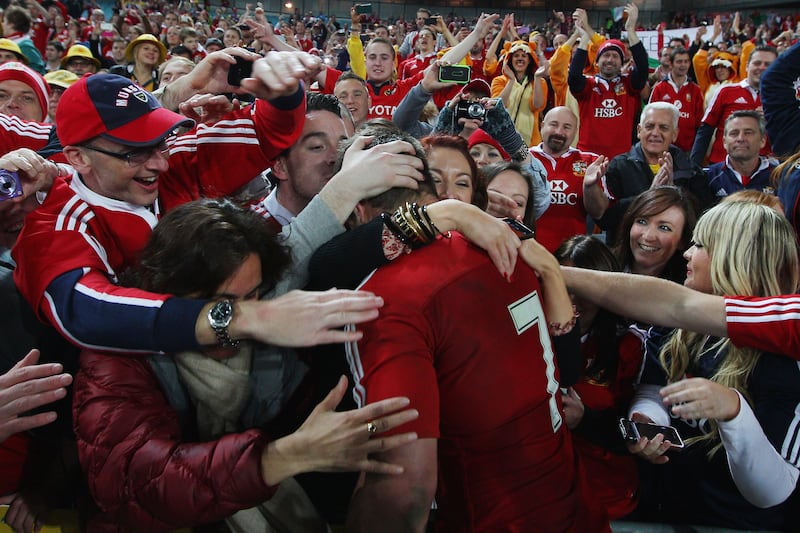In the months before the 1995 World Cup, a battle between two giant Australian media moguls Kerry Packer and Rupert Murdoch to dominate satellite television had engulfed rugby. Professionalism was coming, for better or for worse, but the sport was deeply divided about what direction it would take.
Rugby was in danger of tearing itself apart. In the midst of this calamity, I was working for the New South Wales Rugby Union (NSWRU), an organisation that found itself at the epicentre of a struggle for the soul of the game.
Despite the NSWRU being the second oldest rugby union on the planet, in that crisis I learned that the old aristocracies of Ireland, England, Scotland and Wales were not about to send the cavalry from the north to help save us convicts in the south.
At that time, Ian Ferrier was the brilliant chairman of the NSWRU. At the peak of the crisis, with scores of players set to defect to a newly organised World Rugby Corporation made up of professional franchises, he memorably said to me: “Son,” a term of great endearment, “the cavalry is not coming. We have to save ourselves”.
READ MORE
As a first hand witness fighting inside the rugby revolution, I have no doubt that Ferrier’s exceptional leadership and brave decision-making in that time of grave crisis saved the game. Not only in Australia but globally.
On a Sydney spring evening, with the battle at its zenith, I attended a board meeting when Ian declared the game of union “open” in New South Wales. If rugby had not embraced professionalism, the game would have collapsed in New South Wales, a calamitous situation for Australian Rugby.
It was the most seismic decision in rugby history since William Webb Ellis picked up the ball in a game of soccer. The NSWRU immediately began to contact players and the global rebel organisation collapsed. We knew that the cavalry was not coming. We had to save ourselves and we did.
Four years later at the 1999 World Cup, the Wallabies lifted the William Webb Ellis trophy. From being perilously close to oblivion to world champions in under 48 months was some journey.
Twenty-nine years later, and once again Australian Rugby is in dire straits. Not because of a hostile rebel takeover on this occasion, but because of a thrashing at the hands of the Pumas in Santa Fe. That defeat triggered parts of the northern rugby media to call for this season’s Lions tour of Australia to be rerouted to South Africa. Proof that many in the north do not care about the long-term health of the global game.
The short-term memory of those calling for the change has also forgotten that the last Lions tour to South Africa was one giant unmitigated disaster for our game.
The uniqueness of a Lions tour is a major plank in Rugby Australia’s (RA) plan to regain financial autonomy and re-establish rugby’s presence in the Australian sporting landscape. The fact that RA have already sold the majority of tickets and there is no chance of them refunding a penny has also slipped many minds.
There is strong evidence that RA’s strategy has solid foundations which has received zero coverage in the north. September in Australia is the climax for both Rugby League (NRL) and the Aussie Rules (AFL) season. Giant playoff matches for these codes were held in Sydney last weekend, just as the Bledisloe Cup Test match was being played in Sydney.
The AFL semi-final played at the Sydney Cricket Ground drew a crowd of 44,053. The two NRL playoff games held at the Sydney Football Stadium drew a combined attendance of 59,942.
The Bledisloe Cup match played at the Olympic Stadium, pulled in 68,061 rugby geeks. Last year’s Bledisloe Test held inside the colossus of the Melbourne Cricket Ground drew 83,944 rugby diehards.
Rugby in Oz may be in a perilous state, but the Australian rugby public are still turning up in their hundreds of thousands to watch the men in gold.

Lions head coach Andy Farrell will not underestimate the power of Australian rugby to regenerate itself. Farrell was an outstanding Rugby League forward for England. His wholehearted displays won the respect of the Australian Rugby League community. Despite Farrell’s excellence, across many seasons his team suffered at the hands of the Kangaroos.
While revenge is always a powerful emotion in any sport, these bitter experiences will have taught Farrell to never write off any Australian team. English sporting teams have a rich and joyous history of regularly repeating this failure against Australian teams in all sports.
We should also remember that Joe Schmidt is currently selecting only one or two overseas-based players. While this policy is aimed at protecting the integrity of the Super Rugby franchises, it is clear that Australia does not have the depth in its talent pool to sustain a winning Wallabies team with these players alone.
The likes of La Rochelle’s Will Skelton and the Waratahs player of the year, Lachlan Swinton, who has recently joined Bordeaux are desperately needed. The push to select Wallabies from across the globe is gaining momentum. By the time of the Lions tour, I believe it will be policy.
Added to this is the return to rugby from league of Joseph Sua’ali’i. A rugby schoolboy sensation, Sua’ali’i will join Joe Schmidt’s team for the November internationals. He is a superb athlete who plays either fullback or centre.
While the Lions can select from four national teams, they can only have 15 players on the field. As the Wallabies showed against the 2001 Lions, it is conceivable that by July of next year Australia could assemble a squad that can give the north much more than they were expecting.
The Wallabies know that the cavalry is not coming. As it has always been, they must rescue themselves.
















